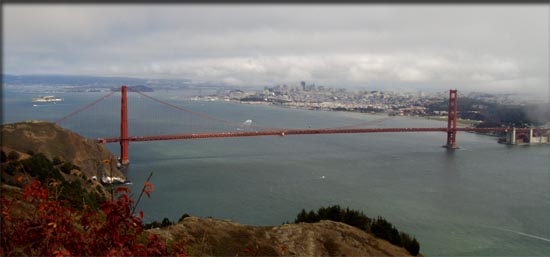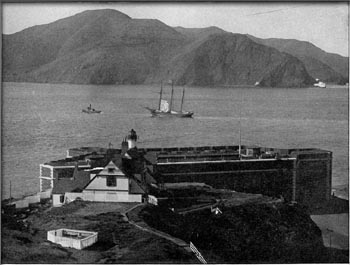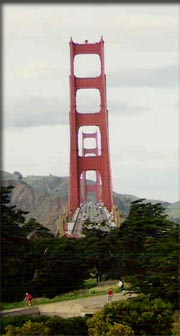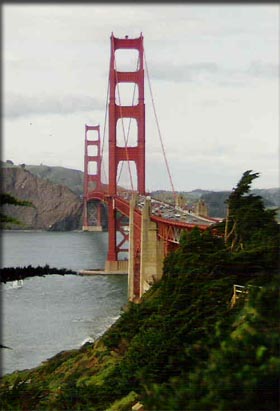| Bridge
Across the Golden Gate |
 |

The
Golden Gate Bridge was the longest suspension bridge
in the world when it was completed. in 1937. (Copyright
Lee Krystek, 2011)
|
They
said it couldn't be built.
The
strait that connects the Pacific Ocean with the San Francisco
Bay is one of the most unforgiving stretches of water in the
world. It is 6,700 ft (2,042 m) wide and in the center 500 ft
(150 m) deep. Because of the tides moving in and out of the
bay the water is subject to strong, swirling currents. Sometimes
as the air is forced between the high hills on either side (which
is called the "gate"), heavy, gusting winds result that can
move as fast as 75 miles per hour. When the wind drops, the
area is also often shrouded in heavy fog with near zero visibility.
In 1916, because of these factors, San Francisco's city engineer,
Michael M. O'Shaughnessy, estimated that a bridge to span the
strait would cost $100 million to construct, an incredible amount
of money for that period of time.
Boca
del Puerto de San Francisco
|
Seven
Quick Facts
|
| -Length:
8,981 feet or (2,737 m) |
| -Height:
Towers 746 ft (227 m) above the water. Deck 260ft (76
m) |
| -Finished:
May 27, 1937 |
| -Cost:
$35 Million |
| -Location:
Entrance to San Francisco Bay, California. |
| -Made
of: Concrete base with steel structure in an Art Deco
design. |
| -Other:
To maintain Its unique International Orange color requires
10,000 gallons of paint a year. |
It took
a long time for European explorers to even realize that the
gate existed. Captains Juan Rodriguez Cabrillo and Francis Drake,
who sailed along the coast in the 16th century missed the entrance
to the bay completely, probably because it was covered in fog.
It wasn't until 1769 that Sgt. José Francisco Ortega, who was
leading an exploration party by land up the coast, found the
strait and reported to his superiors that it prevented him from
traveling any further north. In 1775 Juan de Ayala with his
ship the San Carlos actually entered the bay and landed on Angel
Island, which is named in his honor. Less than a decade later
the Spanish established a Fort and a mission on the southern
hill of the gate and gave it the name Boca del Puerto de San
Francisco with meant "Mouth of the Port of San Francisco."
That
name stuck until the 1840's when John C. Frémont, an American
explorer, military man and later politician, referred to the
area in his memoirs as the "Chrysopylae", or "Golden Gate" because
it reminded him of the "Golden Horn" near Istanbul. This more
picturesque term quickly replaced the older one, especially
after the discovery of gold in California in 1848.
With
its fine harbor, San Francisco quickly became a major city in
the 19th century. Because of its location out on a peninsula,
with the Pacific Ocean to the west and the San Francisco Bay
to the East, it became dependent to ferry service to move goods
and people to and from the other bayside communities. As the
city entered the 20th century people began to recognize that
the lack of bridges into the city was slowing its growth. Though
there had been talk about building a bridge across the gate
for many years, in 1916 a proposal for a bridge written by editor
James Wilkins in the newspaper the San Francisco Bulletin
got everyone's attention and prompted O'Shaughnessy to make
his estimate.
|

The
gate to the bay in the late 19th century before the bridge
was built.
|
The
Challenge to Design the Bridge
O'Shaughnessy
decided to reach out to other bridge engineers to see if they
could come up with a way to bring the cost of such a structure
within reason. Joseph Strauss was one those that responded.
Though Strauss's actual experience was limited to smaller drawbridges,
as an engineering student he had designed a 55-mile (89 km)
long railroad bridge across the Bering Strait between Russian
and the United States. The Golden Gate was a challenge to his
liking and he proposed a cantilever bridge with a suspended
span in the very center that he thought could be built for $17
million.
No money
was available for a bridge though until 1923, however, when
the Golden Gate Bridge and Highway District Act was put into
place giving the nearby counties the right to organize, borrow
money, issue bonds, construct a bridge and collect tolls from
it. Then in 1928 the Golden Gate Bridge and Highway District
was formed to actually finance and erect the bridge and things
started moving forward quickly.
The
agency selected Strauss as chief engineer and hired a number
of consulting engineers including Leon S. Moisseiff who had
worked on the design of the Manhattan Bridge over the East River
in New York and the Ben Franklin Bridge over the Delaware River
in Philadelphia. Another important engineer involved was Charles
Ellis, a former professor of structural and bridge engineering
at the University of Illinois.
Moisseiff
and Ellis reviewed Strauss's original design and though they
deemed it workable, recommended a full suspension bridge instead
for engineering and atheistic reasons. It is fortunate they
did. Strauss's cantilever bridge was sturdy but didn't have
the sweeping lines that are so appreciated in the bridge today.
After reviewing their observations, Strauss agreed that advances
in the science of metals in the previous decade made a simple
suspension bridge more practical and by 1929 the new design
was set. In August of 1930 a permit was finally obtained from
the War Department who had been opposing the bridge, fearing
it might prove a navigation hazard to their ships. Construction
began on January 5th 1933.
|

Each
of the towers stands 746 feet (227m) above the water.
(Copyright Lee Krystek, 2011)
|
Making
the Longest Suspension Bridge in the World
The
first steps in building the bridge were to construct the anchorages
on either side to tie down the bridge's two main cables. This
required a huge amount of concrete and plants were built on
both the north and south sides of the gate to meet the need.
The anchorages took three years to finish and were completed
in 1936.
At the
same time the two towers, the highest ever built for a suspension
bridge, were started. The north one was located on shore which
made construction easier, but the south tower was in the water
over a thousand feet from the southern bank. To create an artificial
island to put the tower on construction crews lowered concrete
"fenders" 30 feet long down to the sea bed. The fenders enclosed
an area about the size of a football field which was then pumped
out and filled with concrete. The steel tower was then constructed
on top of that. Once the towers and anchorages were in position,
then work on the main cables could start.
Unlike
other designs a suspension bridge's strength rests on its cables.
In the case of the Golden Gate Bridge the main cables are 36
inches in diameter and contain 27,572 individual galvanized
steel wires. The cables are anchored in concrete at either end
and run 7,650 ft (2,332 m) over the top of the two towers. The
weight of the roadbed and all the traffic on it is transmitted
up to the main cables by 250 pairs of vertical suspender cables.
The load on the main cables is then transmitted to the towers
(61,500 tons or 56,000,000 kg for each tower) as a downward
force.
Moisseiff
came up with the idea of allowing the roadbed to flex a bit
in the breeze and transmitting the forces caused by the wind
through the cables to the towers . This made the deck lighter
and thinner then on pervious suspension bridge designs. This
saved time and money and also made the bridge more ascetically
pleasing. Moisseiff later applied an even more extreme version
of this idea to the Tacoma Narrows Bridge which he designed
a few years later. Unfortunately, in that case he made the roadbed
too flexible and only a few months after it opened in 1940,
the bridge deck started oscillating wildly in a forty mile-per
hour wind, and after a few hours collapsed.
Near
the end of construction on the Golden Gate a terrible accident
happened. Strauss had designed a safely netting that was suspended
under the bridge to catch members of the construction crew who
lost their balance. Because the bridge's deck was so high, around
250 feet, someone falling off the bridge would not only be at
risk for drowning in the water, but would also hit the surface
at a speed of over 75 miles per hour. Such an impact, even into
water, is often fatal by itself unless the victim hits the surface
at just the right angle.
The
net Strauss had created saved a number of lives during construction,
but on Feb. 17, 1937, a 5-ton work platform fell from the bridge
into the net along with 10 workers. The safety device, under
the strain, slowly gave way and the workers, entangled in the
net, drowned.
One
of the last jobs was to paint the bridge. Architect Irving Morrow,
who was responsible for the bridge's art deco appearance (a
style that emphasizes bold lines and symmetry), decided to keep
the International Orange color was originally meant only to
be a sealant for the steel. The Golden Gate Bridge has displayed
that unique color ever since. It complements the surrounding
hills and also enhances the bridges visibility in fog.
Opening
Day
The
span of steel was completed at a cost of $35 million and opened
to pedestrians on May 27, 1937. An estimated 200,000 people
walked, ran or roller-skated across it and the next day President
Franklin D. Roosevelt remotely used a telegraph to officially
open it to vehicles.
When
it was opened, at a length of 1.7 miles and with a central span
of 4,200 ft, it was the longest suspension bridge in the world.
Though several bridges have surpassed its record over the years,
it remains perhaps the most beautiful bridge in the world, matched
perfectly with its majestic surroundings.
|

In
1994 the American Society of Civil Engineers named the
bridge one of the Seven Wonders of the Modern World.
(Copyright Lee Krystek, 2011)
|
Though
Strauss is often remembered at the designer of the bridge, much
of the credit should really go to Ellis. The thousands of calculations
necessary to design the bridge were in large part made by him
in an era before computers. For reasons that are still unclear
he was fired part way through the project by Strauss. Despite
this Ellis, obsessed with the finishing the bridge, continued
working on his own time filling some ten books with the needed
calculations, done by hand, to finish the construction.
Unfortunately
the notoriety of the bridge has an unpleasant side effect. It
draws an inordinate number of depressed people to it who commit
suicide by jumping off the span. Despite efforts to address
this by putting suicide hotline telephones on the bridge and
increasing security, it is estimated that more than 30 people
perish this way per year. Because the bridge is often shrouded
in fog and the strong currents may wash bodies out to sea, many
of the deaths go unnoticed.
The
Golden Gate Bridge has become beloved symbol of the City of
San Francisco and thousands of tourists come to see the bridge
that couldn't be built each day. In 1994 the American Society
of Civil Engineers named it as one of the seven wonders of the
modern world.

Copyright
Lee Krystek 20011. All Rights Reserved.